Learn about the unique and shared design elements of the $20 note that celebrates the historic reign of Queen Elizabeth II.
Design elements of the commemorative note
The theme: A Historic Reign
Her Majesty Queen Elizabeth II has been prominently featured on our bank notes throughout her reign. Her first appearance was actually as 8-year-old Princess Elizabeth, on the first $20 note issued by the Bank of Canada in 1935. With only one exception, each subsequent series has featured a portrait of the Queen on the $20 denomination.
The commemorative $20 note was issued on 9 September 2015, the day on which Queen Elizabeth II’s reign exceeded that of her great-great-grandmother, Queen Victoria, making her Canada’s longest-reigning sovereign.
Unique design elements
The commemorative note is a variation of the existing Polymer series $20 note that already features a portrait of the Queen. The difference is that the large window contains new visual elements.
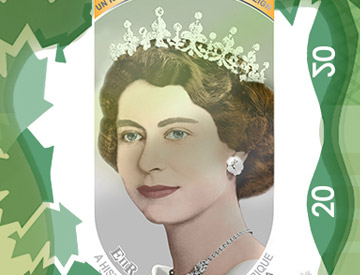
The Karsh photograph was originally commissioned for a Canadian postage stamp then modified for use by the Bank of Canada.
Metallic portrait of the Queen
The metallic portrait in the large window is based on a photograph of the Queen taken in July 1951 by renowned Canadian photographer Yousuf Karsh.
The same photograph was used to create the portrait engraving of the Queen for the 1954 Canadian Landscape series of bank notes—the first series issued after Her Majesty’s coronation.
While her tiara was not included in the portrait for that series, the Bank wanted to do something unique for the commemorative note. This marks the first time that Queen Elizabeth II is shown wearing any type of crown on a Canadian bank note.
As is the case with all depictions of the Queen for previous Canadian bank notes, the metallic portrait image used on the commemorative $20 note was approved by Her Majesty.
For more information on previous depictions of Queen Elizabeth II on Canadian bank notes, explore the retrospective Portraits in Time.
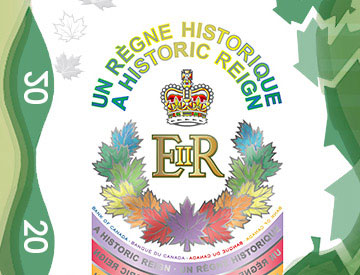
The garland of maple leaves represents Canada’s 13 provinces and territories.
Metallic symbols
The metallic symbols include the Queen’s monogram surmounted by the St. Edward's Crown. “E II” refers to Elizabeth II and “R” is for Regina, meaning “Queen” in Latin (read more about the Royal Cypher). The garland of maple leaves was inspired by the Queen’s Diamond Jubilee Emblem for Canada. The maple leaves in the emblem rising up in a wreath formation represent Canada’s provinces and territories. These various symbols were adapted for use as holographic features.
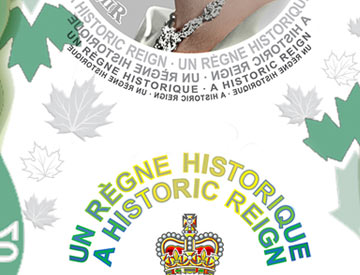
This text sometimes appears in reverse to be legible on both sides of the note.
A historic reign
Text that reads, “A HISTORIC REIGN • UN RÈGNE HISTORIQUE” is repeated across the top, centre and bottom of the large window. This text sometimes appears in reverse to be legible from the other side of the note.
The Estate of Yousuf Karsh, Canadian Secretary to the Queen and Canadian Heritage were consulted to ensure rightful and appropriate depictions of these design elements.
Shared design elements
The other design elements on this bank note are the same on both the Polymer series $20 note and the commemorative variation. They are the large portrait of the Queen and the images on the back depicting the Canadian National Vimy Memorial.

Her Majesty Queen Elizabeth II
The portrait
The portrait of Queen Elizabeth II is an engraving by Jorge Peral, Vice-President, Design and Master Engraver with Canadian Bank Note Company Limited. It is based on a photograph taken by Ian Jones, specially commissioned by the Bank and replicated for the holographic image.
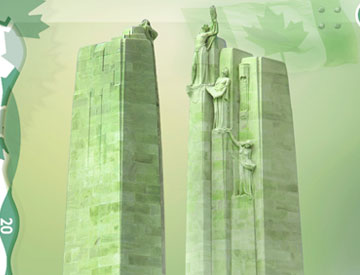
The two pylons of the Vimy memorial represent the sacrifices of people from Canada and France
The Canadian National Vimy Memorial
The Canadian National Vimy Memorial bears the names of the 11,285 Canadian First World War servicemen with no known resting place in France. The following words are inscribed on the base of the monument: “To the valour of their countrymen in the Great War and in memory of their sixty thousand dead this monument is raised by the people of Canada.”
The monument is adorned with 20 allegorical figures. Among them is a group known as "The Chorus." They represent the virtues of Peace, Justice, Hope, Charity, Faith, Honour, Truth and Knowledge. Reaching upward with a torch, Peace is the highest figure on the monument.
Designed by Canadian sculptor and architect Walter Seymour Allward, the monument features two pylons that stand 30 metres high. With a maple leaf carved in one and a fleur-de-lis in the other, the pylons represent the sacrifices of people from Canada and France.
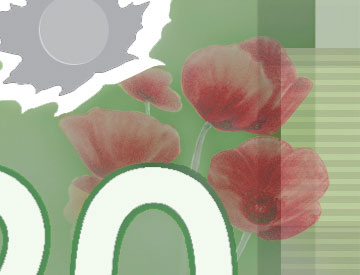
In France during the First World War, poppies often still bloomed on lands devastated by war
Poppies
This artistic rendering of poppies symbolizes remembrance and honours Canada’s military men and women. The presence of red poppies in battlefields and burial grounds throughout Europe during the First World War inspired the symbol of remembrance that we know today. Mourning the death of a friend, Canadian military doctor and artillery commander Major John McCrae wrote “In Flanders Fields,” the now-famous poem that reflects on the living presence of poppies in a landscape devastated by war.
Today, the poppy has become an international symbol of remembrance and those worn on lapels all over the western world can trace their roots directly to McCrae’s poem.

In February 2015, the flag turned 50 years old
The Canadian flag
The Canadian flag’s presence here indicates that although the Vimy memorial is not in Canada, it is actually on Canadian soil, granted by the Government of France to the people of Canada, for all time. Vimy Ridge is a 14-kilometre long escarpment that overlooks the Douai plain of northern France, near the city of Arras. The Canadian National Vimy Memorial is located on the highest point of the ridge.
Bank note specifics
- Portrait: Her Majesty Queen Elizabeth II
- Signatures: Left - C. A. Wilkins, Right - S.S. Poloz
- Size: 152.4 x 69.85 mm (6.0 x 2.75 inches)
- Issue date: 9 September 2015
- Theme: A Historic Reign
For more information, visit www.vimyfoundation.ca